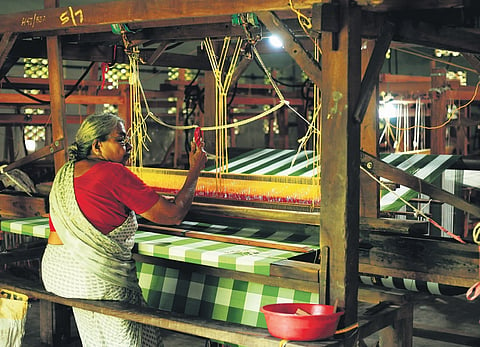

KOCHI: Known as the best fabric in Kerala, the Chendamangalam handloom is struggling to hold on to its legacy. Even as its master craftspersons are ageing, Chendamangalam is finding it hard to attract the young generation of weavers into its fold.
Among the 13 handloom societies in Ernakulam district, the Chendamangalam handloom sector in Paravoor taluk comprising five societies has an uphill task ahead: around 70% of their members are above 60. While a daily wage worker in the construction field earns Rs 900 to 1,200 a day, a handloom weaver receives merely Rs 250 to 300. Further, the lack of job security keeps the youth away from the sector, officials say.
The weavers in Chendamangalam, the ancient handloom village with Geographical Identification tagging, are known for their expertise in producing authentic Kerala attire like the ‘set-mundu’ and the ‘kasavu’ saree for weddings, besides the common bath towel ‘thorthu’.
“Handloom needs high subtlety, from boiling the yarn to turning it into a piece of cloth. Most of the societies are surviving with tiny orders. It’s difficult to meet these orders by depending solely on an elderly workforce,” says C S Saritha, secretary of the Kuriyapilly Handloom Society.
The sector continues to survive because of various grants and allowances from the state government, which has been pending from 2019, she points out. As a representative of the 24-member handloom society, Saritha asserts the introduction of new products and designs can change the situation for the better.
P A Sojan, a former secretary of the Chendamangalam Handloom Weavers’ Cooperative Society, is concerned over the declining numbers of workers in the sector.
“Each handloom society had more than 650 workers 15 years ago. Now the five societies in Paravoor are working with 600 to 650 workers and about 200 allied workers. Moreover, they are knitting less than 10% of the actual need,” he says.
If a worker weaves four metres (the normal size of a ‘double mundu’) a day, and if it is priced at Rs 1,000, the weaver gets only Rs 200 to 250 a day, Sojan points out.
“Through a power loom (mechanised loom), the production will increase and reach the market for Rs 250-400/dhoti. But it won’t have the quality of handmade fabric,” stresses Sojan, who has 42 years of experience in the handloom sector.
He admits that government grants and allowances like the subsidies for hank yarn and chemicals, rebates for school uniforms, and grants for exhibitions and handloom machines upgrading help workers overcome some of their problems.
Ramesh Menon, an active member of the nonprofit group ‘Save the Loom’ working to revive, restore and restructure the handloom industry, says the number of workers in the Chendamangalam handloom sector has dwindled drastically over the past several years.
“Around five lakh workers have dropped out of the handloom sector during the past 20 years,” he says.
Though the records point out that there are more than 1,000 registered members in each society, the number of active members is merely 7-8% of that count, says Ramesh, whose organisation conducted door-to-door surveys in Chendamangalam following the 2018 flood.
Paravoor Handloom Society president T S Baby feels the youth do not see any hope in the handloom sector as there are no significant earnings.
“It’s difficult to live with a small profit, where a towel produced at a cost of around Rs 110 is sold for Rs 140,” he adds.